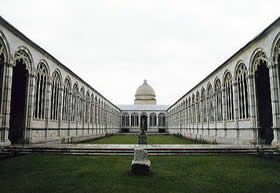Pisa - The Monumental Cemetery

Giovanni di Simone started the Camposanto in 1277. It is an ancient cemetery closed by four porticoes and delimitating the north side of the Piazza del Duomo. It is a vast cloister framed by paved arcades. Many Roman patrician sarcophagi and numerous funeral monuments dedicated to famous people of the Pisan science and literature were brought here.
According to tradition, around the end of the XIII century, the Archbishop Ubaldo de' Lanfranchi ordered that some earth coming from the Golgotha, the place where Jesus was crucified, was placed inside the four-sided portico of the Camposanto. Some crusaders brought it in Pisa on their way from the Holy Land.
The building was slowly finished around that rectangle of holy earth in the following centuries. As a matter of fact, by 1358, the foundations of the northern side had not been excavated yet. This is also why the Gothic style could overlap the pre-existing Romanesque-Pisan style giving life to a very interesting and original work.
Only around the first half of the XV century the Camposanto was completed, while the Dal Pozzo chapel was added at the end of the XVI century.
In the XVI century, the four long corridors of the portico started to be painted in fresco. Unfortunately, numerous works by Benozzo Gozzoli, Piero di Puccio and Spinello Aretino were seriously damaged during the bombardments of 1944. Only the "sinopias", the preparatory sketches, were left and are kept inside the Museo delle Sinopie.
The "Trionfo della Morte", a work attributed to Buonamico Buffalmacco, was only damaged. It represents a dramatic allegory, where the happy life of some young people is depicted with a background of open tombs.
There are two doors along the south side of the Camposanto. They are surmounted by a Gothic tabernacle which contains a "Madonna e Santi" by Giovanni Pisano. In the west corridor, instead, the remains of the chains that closed Pisa's port, can be admired. They were taken by the Genoese rivals who won in the Meloria battle in 1284 and they gave them back to the city only in 1860.
Also the Camposanto, as well as the Baptistery and the Dome, is somehow linked to the famous figure of Galileo Galilei. The votive lamp that, according to the legend, inspired the observations on the oscillation of the pendulum to this well-known scientist, is kept inside the Cappella Aulla.